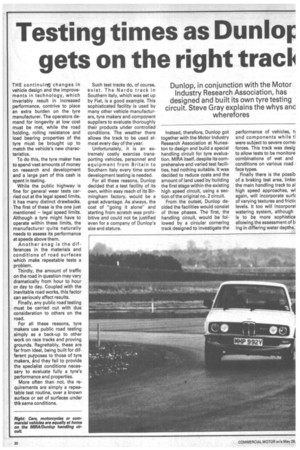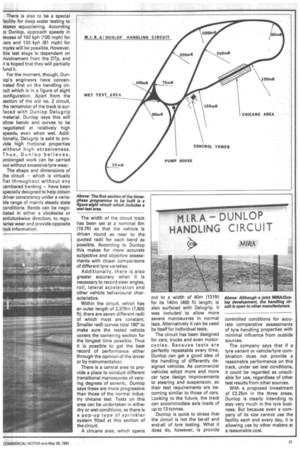Testing times as Dunlor gets on the right tracli
Page 22

Page 23

If you've noticed an error in this article please click here to report it so we can fix it.
THE continuirvg changes in vehicle design and the improvements in technology, which invariably result in increased performance, contrive to place an extra burden on the tyre manufacturer. The operators demand for longevity at low cost must be met, while the road holding, rolling resistance and load bearing properties of the tyre must be brought up to match the vehicle's new characteristics.
To do this, the tyre maker has to spend vast amounts of money on research and development and a large part of this cash is spent in testing.
While the public highway is fine for general wear tests carried out at the legal speed limits, it has many distinct drawbacks. The first of these is the one just mentioned — legal speed limits. Although a tyre might have to operate within these limits, the manufacturer quite naturally needs to assess its performance at speeds above them.
Another snag is the differences in the materials and conditions of road surfaces which make repeatable tests a problem.
Thirdly, the amount of traffic on the road in question may vary dramatically from hour to hour or day to day. Coupled with the inevitable road works, this factor can seriously affect results.
Finally, any public road testing must be carried out with due consideration to others on the road.
For all these reasons, tyre makers use public road testing simply as a back-up to other work on race tracks and proving grounds. Regrettably, these are far from ideal, being built for different pufposes to those of tyre makers, nd they fail to provide the specialist conditions necessary to evaluate fully a tyre's performance and properties.
More often than not, the requirements are simply a repeatable test routine, over a known surface or set of surfaces under the same conditions. Such test tracks do, of course, exist. The Nardo track in Southern Italy, which was set up by Fiat, is a good example. This sophisticated facility is used by many other vehicle manufacturers, tyre makers and component suppliers to evaluate thoroughly their products under controlled conditions. The weather there allows the track to be used almost every day of the year.
Unfortunately, it is an extremely costly exercise transporting vehicles, personnel and equipment from Britain to Southern Italy every time some development testing is needed.
For all these reasons, Dunlop decided that a test facility of its own, within easy reach of its Birmingham factory, would be a great advantage. As always, the cost of "going it alone" and starting from scratch was prohibitive and could not be justified even for a company of Dunlop's size and stature. Instead, therefore, Dunlop got together with the Motor Industry Research Association at Nuneaton to design and build a special handling circuit for tyre evaluation. MIRA itself, despite its comprehensive and varied test facilities, had nothing suitable. It was decided to reduce costs and the amount of land used by building the first stage within the existing high speed circuit, using a section of the original no. 2 circuit.
From the outset, Dunlop decided the facilities would consist of three phases. The first, the handling circuit, would be followed by a circular cornering track designed to investigate the performance of vehicles, t) and components while ti were subject to severe corne: forces. This track was desig to allow tests to be monitore combinations of wet and conditions on various road : face types.
Finally there is the possib of a braking test area, linkei the main handling track to al high speed approaches, wl again, will incorporate surfe of varying textures and frictic levels. It too will incorporai watering system, although is to be more sophistica allowing the assessment of b ing in differing water depths.
There is also to be a special facility for deep water testing to MOSS aquaplaning. According to Dunlop, approach speeds in excess of 160 kph (100 mph) for cars and 130 kph (81 mph) for trucks will be possible. However, this last stage is dependant on involvement from the DTp, and it is hoped that they will partially fund it.
For the moment, though, Duniop's engineers have concentrated first on the handling circuit which is in a figure of eight configuration. Apart from the section of the old no. 2 circuit, the remainder of the track is surfaced with Dunlop Delugrip material. Dunlop says this will allow bends and curves to be negotiated at relatively high speeds, even when wet. Additionally, Delugrip is said to provide high frictional properties without high abrasiveness. Thus, Dunlop believes, prolonged work can be carried out without excessive tyre wear.
The shape and dimensions of the circuit — which is virtually Flat throughout without any cambered banking — have been specially designed to help obtain driver consistency under a variable range of mainly steady state conditions. Bends can be negotiated in either a clockwise or anticlockwise direction, to regularise wear and provide opposite lock information. The width of the circuit track has been set at a nominal 6m (19.7ft) so that the vehicle is driven round as near to the quoted radii for each bend as possible. According to Dunlop this makes for more accurate subjective and objective assessthents with closer comparisons of different tyre varieties.
Additionally, there is also greater accuracy when it is necessary to record steer angles, roll, lateral acceleration and other vehicle behavioural characteristics.
Within the circuit, which has an outer length of 2,379m (7,805 ft), there are seven different radii of which most are constant. Smaller radii curves total 180° to make sure the tested vehicle covers the cornering section for the longest time possible. Thus it is possible to get the best record of performance either through the opinion of the driver or by instrumentation.
There is a central area to provide a place to conduct different transitional manoeuvres of varying degrees of severitN. Dunlop says these are more progressive than those of the normal industry chicane test. Tests on this area can be undertaken in either dry or wet conditions, as there is a pop-up type of sprinkler system fitted at this section of the circuit.
A chicane area, which opens out to a width of 40m (131ft) for its 140m (460 ft) length, is also surfaced with Delugrip. It was included to allow more severe manoeuvres in normal laps. Alternatively it can be used by itself for individual tests.
The circuit has been designed for cars, trucks and even motorcycles. Because tests are perfectly repeatable every time, Dunlop can get a good idea of the handling of differently designed vehicles. As commercial vehicles adopt more and more car type design improvements to steering and suspension, so their test requirements are becoming similar to those of cars. Looking to the future, the track can accommodate axle loads of up to 13 tonnes.
Dunlop is quick to stress that the circuit is not the be-all and end-all of tyre testing. What it does do, however, is provide
controlled conditions for accurate comparative assessments of tyre handling properties with minimal influence from outside sources.
The company says that if a tyre variant or vehicle/tyre combination does not provide a reasonable performance on this track, under set test conditions, it could be regarded as unsuitable for use, regardless of other test results from other sources.
With a proposed investment of £2.25m in the three areas, Dunlop is clearly intending to stay very much in the tyre business. But because even a company of its size cannot use the facility each and every day, it is allowing use by other makers at a reasonable cost.
































































